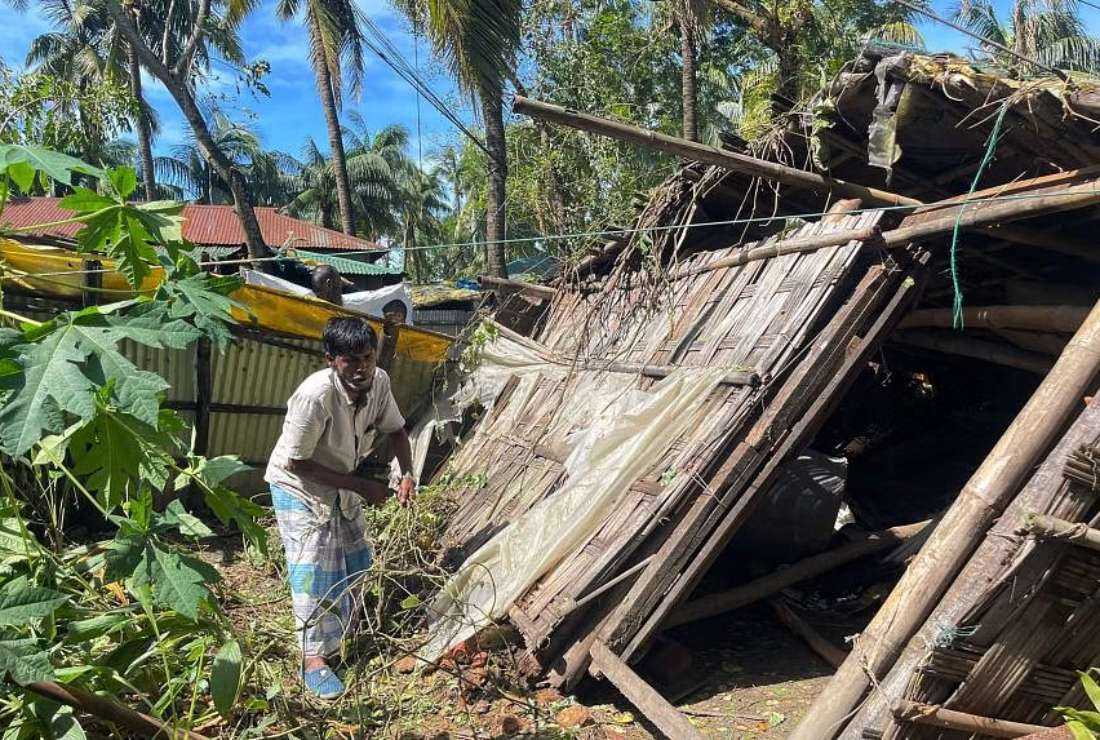Rohingya refugee camps sheltering about one million people in Cox’s Bazar survived without major damage

A man inspects his damaged home in Cox’s Bazar of southeast Bangladesh after Cyclone Hamoon made landfall, on Oct 25. (Photo: AFP)
At least five people died and nearly 275,000 others fled their homes in Bangladesh’s southern coastal districts, after Cyclone Hamoon slammed into the country, officials said.
Hamoon started pummeling the Bangladesh coast on Oct. 24 bringing strong winds and heavy rain that left thousands of houses damaged in Chattogram and Cox’s Bazar districts.
Disaster Management Department chief, Mijanur Rahman, confirmed two deaths in Chattogram and three others in Cox’s Bazar.
Roads in many parts of the cyclone-hit areas were impassable for hours.
Although, power lines were cut, and intense rainfall lashed coastal villages and islands, there were no reports of major widespread damage, AFP reported Kamrul Hasan, secretary of the disaster management ministry as saying.
“Storm caught people in Cox’s Bazar off guard”
“We evacuated 273,352 people to cyclone shelters,” Hasan said, adding that two people died. One was crushed by a fallen tree, while another was killed when a building collapsed.
“At least 10 people were injured and are being treated in hospitals.”
There were no reports of significant damage to refugee camps in Cox’s Bazar that houses about one million Rohingya people who fled a military crackdown in neighboring Myanmar.
The storm caught people in Cox’s Bazar off guard as the nation’s most popular tourist destination was not among 10 districts the authorities marked for mass evacuation under their Cyclone Preparedness Program.
Disaster management official, Rahman, said they have allocated 550 tons of rice and 44 million taka (US$528,689) for 11 cyclone-affected districts.
Catholic charity Caritas Bangladesh has dispatched teams to take stock of the situation.
“The worst hit places included Cox’s Bazar and Moheshkhali,” said Daniel Sipu Gomes, a Caritas disaster management officer in the Chattogram region.
“We are assessing if we need to respond after the prompt relief response of the government,” he said.
“Rohingya refugee camps survived without major damage”
Hamoon is the latest major storm to batter Bangladesh’s coast, with the low-lying South Asian nation witnessing an increasing number of severe weather events as climate change fuels bigger and deadlier storms.
Bangladesh Meteorological Department expert, Muhammad Abul Kalam Mallik, said Hamoon made landfall early on Oct. 25 in the Chittagong and Cox’s Bazar coastal districts with wind speeds of up to 104kph.
“It is likely to move further inland and weaken gradually,” Mallik said.
Hasan said the Rohingya refugee camps survived without major damage as the makeshift shelters did not fall in the main path of the cyclone.
Cox’s Bazar district lost power late on Oct. 24 as the storm approached and district officials could not be reached for updates on damage caused.
Climate change has increased the intensity of tropical storms, with more rain and stronger gusts leading to flash floods and coastal damage, experts say.
In May, Cyclone Mocha became the most powerful storm to hit Bangladesh since Cyclone Sidr in November 2007. Sidr killed more than 3,000 people and caused billions of dollars in damage.
In recent years, better forecasting and more effective evacuation planning have dramatically reduced the death toll from such storms.

